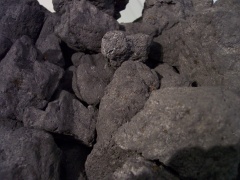Metallurgical coke
| Infobox on Metallurgical coke | |
|---|---|
| Example of Metallurgical coke |  |
| Facts | |
| Origin | - |
| Stowage factor (in m3/t) | - |
| Humidity / moisture | - |
| Ventilation | - |
| Risk factors | - |
Metallurgical coke
Description / Application
Metallurgical coke, is a carbon material manufactured by the "destructive distillation" of various blends of bituminous coal.
Coke is a solid carbonaceous residue derived from low-ash, low-sulfur bituminous coal from which the volatile constituents are driven off by baking in an oven without oxygen at temperatures as high as 1,000° C so that the fixed carbon and residual ash are fused together.
Metallurgical coke is used as a fuel and as a reducing agent in smelting iron ore in a blast furnace. The product is too rich in dissolved carbon, and must be treated further to make steel. The coke must be strong enough to resist the weight of overburden in the blast furnace, which is why coking coal is so important in making steel by the conventional route. However, the alternative route is direct reduced iron, where any carbonaceous fuel can be used to make sponge or pelletised iron.
Coke from coal is grey, hard, and porous and has a heating value of 24.8 million Btu/ton (29.6 MJ/kg). Some coke making processes produce valuable by-products that include Coal Tar, ammonia, light oils, and coal gas.
Petroleum coke is the solid residue obtained in oil refining, which resembles coke, but contains too many impurities to be useful in metallurgical applications.
See Coal and Coke for further particulars.











